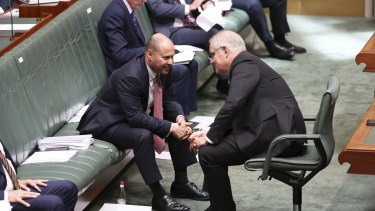The secret sauce missing from Morrison’s recovery recipe
According to Reserve Bank deputy governor Dr Guy Debelle, a big lesson from the global financial crisis was “be careful of removing the stimulus too early”. Good point, and one that could yet bring Scott Morrison and his nascent economic recovery unstuck. But there’s something that’s even more likely to be his – and our – undoing.
Debelle was referring to the way the British and other Europeans, having borrowed heavily to bail out their banks and stimulate a recovery in the real economy, took fright at their mountain of debt and, before the recovery had got established, undercut it by slashing government spending. The consequences – contributing to more than a decade of weak growth – are hardly to be recommended.

The Yanks have been doing something similar this time round, with the Republican-controlled Senate agreeing to a huge initial stimulus package but, with the nation caught in a ferocious second round of the pandemic, having so far steadfastly refused a second package.
It almost seems a design flaw of conservative governments always to be tempted to pull the plug too early.
So premature withdrawal of stimulus is certainly a significant risk to the strength of our recovery. But I doubt it’s the biggest one. We should be giving much more thought than we have been to the sources of growth that will keep the economy heading onward and upward once the stimulus peters out.
The basic idea of managing the macro economy is that, when it’s flat, you use budgetary and interest-rate stimulus to give it a kick start, but then all the usual, natural drivers of growth take over.
Such as? We can talk about population growth, but it could well take more than a year or two to return to its accustomed annual rate of 1.5 per cent. And, in any case, it does far less to increase gross domestic product per person than it suits its promoters to admit.
We can talk about business investment spending but, though it does add to demand for goods and services, it’s essentially derived demand. That is, it doesn’t spring up spontaneously so much as grow in response to the growth in consumers’ demand for the goods and services businesses produce.
This being so, the government’s various tax incentives intended to get businesses investing in advance of the surge in consumer demand are unlikely to get far.
Up to 60 per cent of aggregate demand comes from household consumption. But the strong growth in consumer spending in the September quarter – with more to come this quarter – isn’t a sign that healthy growth in consumption has resumed. It’s just the semi-automatic rebound in spending following the lifting of the lockdown.
The leap in the household saving rate to a remarkable 18.9 per cent of disposable income is some combination of greater “precautionary” saving – “Who knows whether I’ll yet lose my job?” – and pent-up demand caused by the lockdown.
As things return to something reminiscent of normal, we can expect people to run down this excess saving to keep their spending returning to normal despite higher unemployment and widespread wage freezes.
But this is a once-only catch-up, spread over several quarters, not a return to on-going healthy real growth in consumer spending. For this, the occasional tax cut can help – though not by much if its prime beneficiaries are the top 20 per cent of income-earners, as scheduled for July 2024 – but there’s simply no substitute for healthy real growth in the dominant source household income: wages.
Real wage growth is the secret sauce missing from the hoped-for recovery. The Reserve Bank’s latest forecasts are for real wage growth of a mere 0.25 percentage points in each of calendar 2020, 2021 and 2022.
The econocrats don’t want to dampen spirits by admitting what they surely know: that without decent growth in real wages there’s little hope of a sustained recovery. Reserve governor Dr Philip Lowe’s recent remarks say we’re unlikely to see much growth in real wages until a rate of unemployment down to 4.5 per cent means employers must bid up wages in their competition to attract all the skilled labour they need.
This implies that, even if we were to achieve healthy rates of improvement in the productivity of labour – a big if – it’s no longer certain that organised labour retains the bargaining power to ensure ordinary households get their fair share of the spoils; that real wages still grow in line with productivity.
The government and its advisers ought to be grappling with the question of how we can get real wages up – but I doubt that’s what we’ll see this week when it reveals its plans for yet more “reform” of industrial relations.
Ross Gittins is the Herald’s economics editor.
Ross Gittins is the Economics Editor of The Sydney Morning Herald.
Most Viewed in Business
Source: Thanks smh.com